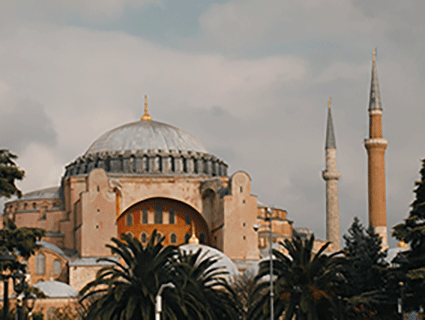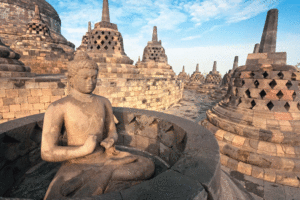P. Pilgrim
Recently I had the opportunity to watch a National Geographical program about the Hagia Sofia an important Byzantine structure and one of the world’s great monuments in Turkey’s capital city Istanbul. It was built as a Christian church in the 6th century AD (532–537) under the direction of the Byzantine emperor Justinian I around 1486 years ago. In subsequent centuries it became a mosque, a museum, and a mosque again. The building reflects the religious changes that have played out in the region over the centuries, with the minarets and inscriptions of Islam as well as the lavish mosaics of Christianity. It was a fascinating program about the construction of the iconic building from its incredible dome to the arch windows and immense size. Hagia Sophia boasted the ancient world’s second largest dome. The biggest was in the Pantheon. However, because the 107-ft dome was supported on four pendatives, it enclosed the largest interior space in antiquity. This central dome rests on a ring of windows and is supported by two semi-domes and two arched openings to create a large nave, the walls of which were originally lined with intricate Byzantine mosaics made from gold, silver, glass, terra cotta and colourful stones and portraying well-known scenes and figures from the Christian Gospels. The breath-taking beauty of the building and the ingenious construction for its time are noteworthy. However, what struck me most was the detailed explanation of how the cement was made. The cement that is still holding the building together today. Modern concrete which contains cement can break down in as few as 50 years. But more than a thousand years after the western Roman Empire crumbled to dust, its concrete structures are still standing. Scientists have recently made a detailed analysis of it to see what properties it contained. To their surprise it called for a concoction of volcanic ash, lime, and seawater, mixed together with volcanic rocks and spread into wooden moulds that were then immersed in more sea water. The researchers found that when seawater percolates through a cement matrix, it reacts with volcanic ash and crystals to form Al-tobermorite and a porous mineral called phillipsite, and this mineral makes the cement grow stronger rather than weaker over time. Thus giving the building the durability to stand firm even through invasions, earthquakes and wars.
The cement seemed like a weak component yet through time and adversity it became strong. This reminded me of the truth contained in 2Co 12: 9, 10 when the apostle Paul said “And he (Jesus Christ) said unto me, My grace is sufficient for thee: for my strength is made perfect in weakness. Most gladly therefore will I rather glory in my infirmities, that the power of Christ may rest upon me.” Therefore, Paul took pleasure in infirmities, in reproaches, in persecutions, in distresses for Christ’s sake: for when he is weak, then he is strong in Christ. This is one of the paradoxes of the Christian faith, when a Christian is weak either physically or spiritually weak through his afflictions, his reproaches, persecutions, for Christ’s sake, then he is strong in the grace of our Lord Jesus Christ. When a Christian sees himself weak in his own body, then he looks to Christ and is able to receive his strength through his divine grace. Wherefore, Christ manifests his power and the sufficiency of his grace to each Christian. They in turn can say ‘When I am weak, then am I strong.’ The cement may seem like a weak component yet through time it becomes stronger to be able to withstand the ravages of time. Christians become stronger the longer they rely on Christ to strengthen them and give them the durability to stand like the Hagia Sofia. pilgrimway101@yahoo.com




